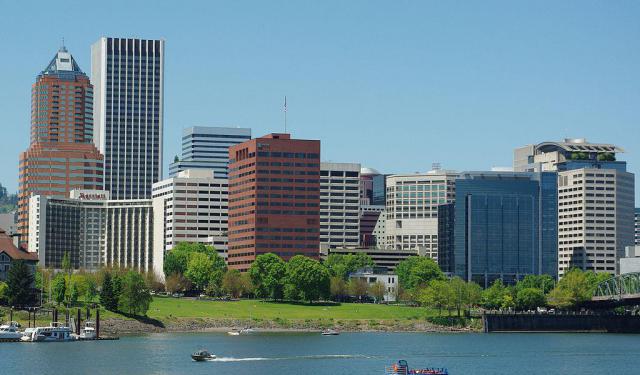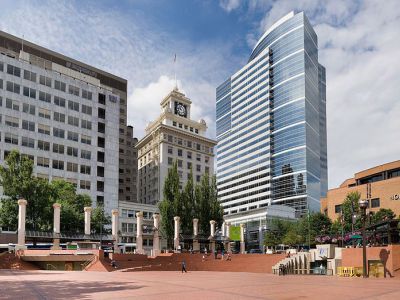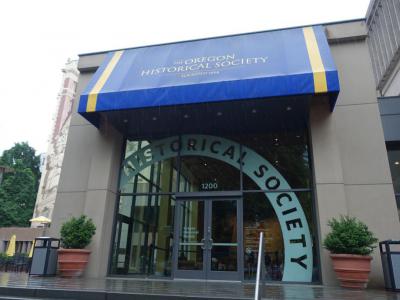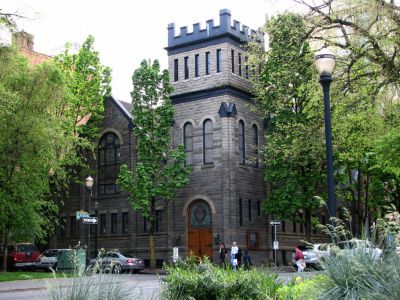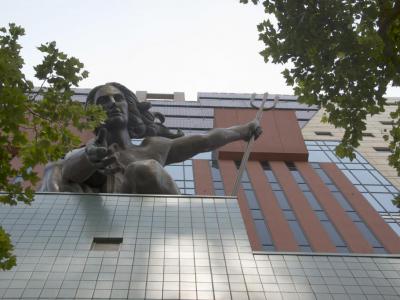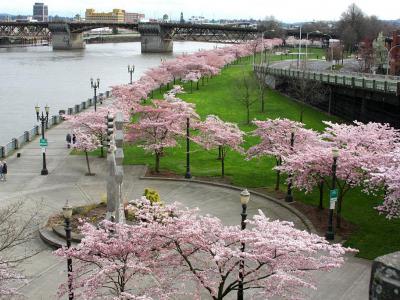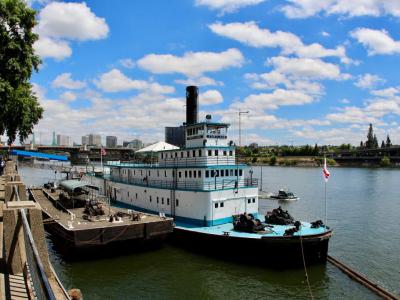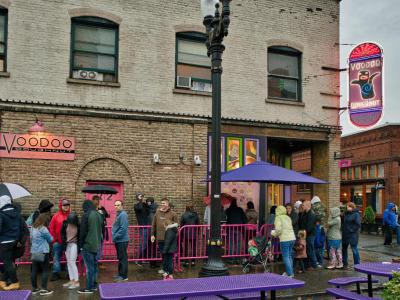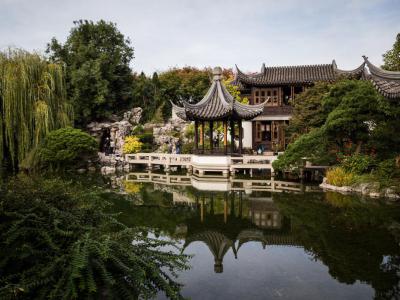Portland Introduction Walking Tour (Self Guided), Portland
Portland, the largest city in the US state of Oregon, was founded at the confluence of the Willamette and Columbia Rivers in a virgin forest, near the end of the Oregon Trail, less than two centuries ago.
Named after Portland, Maine, which is itself named after the English Isle of Portland, the Oregon settlement began to be populated in the 1840s. Portland quickly flourished as a major port city due to its strategic location and was built more on a European model, with streets that feature statues, fountains, and half-size city blocks. Its water access provided convenient transportation of goods, and the timber industry was a major force in the city's early economy.
At the turn of the 20th century, Portland had an ill fame as one of the most dangerous port cities in the world, a hub for organized crime and racketeering. After the city's economy experienced an industrial boom during World War II, its hard-edged reputation began to dissipate. Beginning in the 1960s, Portland became noted for its growing liberal and progressive political values, earning it a reputation as a bastion of counterculture.
Throughout its history, Portland acquired a diverse range of nicknames including "Rose City" or "The City of Roses", "PDX" (the code for Portland International Airport), Bridgetown, Stumptown, Rip City, Soccer City, P-Town, Portlandia, and the more antiquated one – Little Beirut.
In the 1990s, Portland witnessed the rise of its technology industry, notably with the establishment of companies like Intel. Post-2000, the city underwent remarkable growth, fueled by its burgeoning cultural scene and reputation for attracting and retaining a high number of college-educated individuals, particularly young people.
One of its most iconic landmarks is Pioneer Courthouse Square, often referred to as the "living room" of Portland. Also, no visit to the city is complete without indulging in the quirky delights of Voodoo Doughnut, where unconventional flavors and whimsical shapes reign supreme. The Old Town Chinatown Gateway welcomes visitors to explore Portland's diverse cultural tapestry, while the tranquil Lan Su Chinese Garden offers a serene retreat amidst the bustling city streets.
Walking Magazine selected Portland as one of America's best walking cities. We, in turn, offer you the chance to discover Portland complete with its urban architecture, public parks, theme museums, and other delights on this self-guided walk. Enjoy it!
Named after Portland, Maine, which is itself named after the English Isle of Portland, the Oregon settlement began to be populated in the 1840s. Portland quickly flourished as a major port city due to its strategic location and was built more on a European model, with streets that feature statues, fountains, and half-size city blocks. Its water access provided convenient transportation of goods, and the timber industry was a major force in the city's early economy.
At the turn of the 20th century, Portland had an ill fame as one of the most dangerous port cities in the world, a hub for organized crime and racketeering. After the city's economy experienced an industrial boom during World War II, its hard-edged reputation began to dissipate. Beginning in the 1960s, Portland became noted for its growing liberal and progressive political values, earning it a reputation as a bastion of counterculture.
Throughout its history, Portland acquired a diverse range of nicknames including "Rose City" or "The City of Roses", "PDX" (the code for Portland International Airport), Bridgetown, Stumptown, Rip City, Soccer City, P-Town, Portlandia, and the more antiquated one – Little Beirut.
In the 1990s, Portland witnessed the rise of its technology industry, notably with the establishment of companies like Intel. Post-2000, the city underwent remarkable growth, fueled by its burgeoning cultural scene and reputation for attracting and retaining a high number of college-educated individuals, particularly young people.
One of its most iconic landmarks is Pioneer Courthouse Square, often referred to as the "living room" of Portland. Also, no visit to the city is complete without indulging in the quirky delights of Voodoo Doughnut, where unconventional flavors and whimsical shapes reign supreme. The Old Town Chinatown Gateway welcomes visitors to explore Portland's diverse cultural tapestry, while the tranquil Lan Su Chinese Garden offers a serene retreat amidst the bustling city streets.
Walking Magazine selected Portland as one of America's best walking cities. We, in turn, offer you the chance to discover Portland complete with its urban architecture, public parks, theme museums, and other delights on this self-guided walk. Enjoy it!
How it works: Download the app "GPSmyCity: Walks in 1K+ Cities" from Apple App Store or Google Play Store to your mobile phone or tablet. The app turns your mobile device into a personal tour guide and its built-in GPS navigation functions guide you from one tour stop to next. The app works offline, so no data plan is needed when traveling abroad.
Portland Introduction Walking Tour Map
Guide Name: Portland Introduction Walking Tour
Guide Location: USA » Portland (See other walking tours in Portland)
Guide Type: Self-guided Walking Tour (Sightseeing)
# of Attractions: 9
Tour Duration: 2 Hour(s)
Travel Distance: 3.2 Km or 2 Miles
Author: DanaOffice
Sight(s) Featured in This Guide:
Guide Location: USA » Portland (See other walking tours in Portland)
Guide Type: Self-guided Walking Tour (Sightseeing)
# of Attractions: 9
Tour Duration: 2 Hour(s)
Travel Distance: 3.2 Km or 2 Miles
Author: DanaOffice
Sight(s) Featured in This Guide:
- Pioneer Courthouse Square
- Oregon Historical Society Museum
- St. James Lutheran Church
- Portland Building
- Tom McCall Waterfront Park
- Oregon Maritime Museum
- Voodoo Doughnut
- Old Town Chinatown Gateway
- Lan Su Chinese Garden
1) Pioneer Courthouse Square
Pioneer Courthouse Square is Portland's central hub – a pleasant, sunny spot made perfect for sampling the city's essence. The equivalent of a New Mexican/Californian plaza, it hosts food carts, public art pieces (e.g., Seward Johnson's 'Allow Me', also known as 'The Umbrella Man'), a Monday farmers' market, cultural festivals, a visitor center with a clean public bathroom... you name it! The water feature in the form of a cascading waterfall does make this a picture-perfect place.
Part of the square's immediate success in the 1980s was due to its timing, affirming as it did the "new age of the pedestrian" heralded by the transit mall. Designs were submitted from around the world, and models of the best submissions were put on display. The winning scheme was a simple brick-paved plaza with a waterfall, an arc of steps overlooking a central arena, and a whimsical colonnade separating it from the streets. The public was further drawn into the venture by funding construction through buying individual bricks; thus, from the first concept, ordinary people took possession of the square as their own. It is a place where everyone is welcome, a place to see and be seen, or just to chill out amid the hubbub of the working day. Danish architect Jan Gehl who, for more than fifty years, has focused on improving the quality of urban life by helping people to "re-conquer the city", has acclaimed it as one of the world's best public squares.
Part of the square's immediate success in the 1980s was due to its timing, affirming as it did the "new age of the pedestrian" heralded by the transit mall. Designs were submitted from around the world, and models of the best submissions were put on display. The winning scheme was a simple brick-paved plaza with a waterfall, an arc of steps overlooking a central arena, and a whimsical colonnade separating it from the streets. The public was further drawn into the venture by funding construction through buying individual bricks; thus, from the first concept, ordinary people took possession of the square as their own. It is a place where everyone is welcome, a place to see and be seen, or just to chill out amid the hubbub of the working day. Danish architect Jan Gehl who, for more than fifty years, has focused on improving the quality of urban life by helping people to "re-conquer the city", has acclaimed it as one of the world's best public squares.
2) Oregon Historical Society Museum
This (somewhat small) museum in the downtown South Park Blocks is a wonderful place to delve into the past of Oregon and the entire Pacific Northwest. Founded over a century ago, it houses the 1835 penny used to select Portland over Boston as the name for what would become the largest city in the state. Oddly enough, the main permanent exhibit here, the 7,000-sq-ft "Experience Oregon", takes up the upper floor, while temporary galleries along with the museum shop and ticket counter are on the street level with some additional galleries on the lower level.
Visitors enter "Experience Oregon" through a panoramic theater that introduces major themes and sets the stage for the exhibit. Land and water are two the most pervasive topics covered throughout, displaying the diversity of Oregon's landscape, as well as people's historical and ongoing relationships with its resources. Interactive stations include a "Stories from the Archives" tablet game, a canoe-building exercise, a covered-wagon replica visitors can walk through, role-playing games that allow visitors to take sides in historical debates, listening wands that bring to visitors voices from the past, and opportunities to offer ideas and opinions on relevant themes.
On the remaining floors are several additional exhibits – some temporary, such as "Greatest Photographs of the American West" (2020) while others, like the children/family-oriented "History Hub" and "Oregon Voices", which tells the story of post-war social change in the state and the people who have led those changes, are permanent.
Once finished with all the galleries, you can stop by the museum shop for some souvenirs or Oregon history books (they have a pretty interesting collection for sale, though it's not quite clear which books are new and which are used).
Tip:
Overlooking the museum courtyard is the flat side of a building painted with such a wonderful trompe l'oeil (trick of the eye) that, for a moment, you would think it's a building rich in remarkable architectural detail. And then you see that it's not. But it's so well done you don't mind, and it's easy to fall back in.
Visitors enter "Experience Oregon" through a panoramic theater that introduces major themes and sets the stage for the exhibit. Land and water are two the most pervasive topics covered throughout, displaying the diversity of Oregon's landscape, as well as people's historical and ongoing relationships with its resources. Interactive stations include a "Stories from the Archives" tablet game, a canoe-building exercise, a covered-wagon replica visitors can walk through, role-playing games that allow visitors to take sides in historical debates, listening wands that bring to visitors voices from the past, and opportunities to offer ideas and opinions on relevant themes.
On the remaining floors are several additional exhibits – some temporary, such as "Greatest Photographs of the American West" (2020) while others, like the children/family-oriented "History Hub" and "Oregon Voices", which tells the story of post-war social change in the state and the people who have led those changes, are permanent.
Once finished with all the galleries, you can stop by the museum shop for some souvenirs or Oregon history books (they have a pretty interesting collection for sale, though it's not quite clear which books are new and which are used).
Tip:
Overlooking the museum courtyard is the flat side of a building painted with such a wonderful trompe l'oeil (trick of the eye) that, for a moment, you would think it's a building rich in remarkable architectural detail. And then you see that it's not. But it's so well done you don't mind, and it's easy to fall back in.
3) St. James Lutheran Church
Oregon's first English-speaking Lutheran Church, Saint James had its beginning in 1890 in a modest wooden chapel on the corner of SW Park and Jefferson streets in downtown Portland. Over a century later, several significant changes have taken place, with the church having grown from the small, ascetic edifice to a complex that covers over half of a city block.
The Pioneer Chapel was raised in 1891, the main sanctuary was finished in 1907, the education building was completed in 1956 and, finally, the Saint James Apartment complex was completed in 1994. Over the years, however, Saint James grew not only in size, but in reaching its goal of helping people find themselves.
The Saint James building was listed on the National Register of Historic Places in 1975. Stop by to listen to amazing music, hymns and classically-oriented organ, well sung and played. If you're lucky, you can even catch a Jazz Vespers service once a month, featuring some amazing artists.
The Pioneer Chapel was raised in 1891, the main sanctuary was finished in 1907, the education building was completed in 1956 and, finally, the Saint James Apartment complex was completed in 1994. Over the years, however, Saint James grew not only in size, but in reaching its goal of helping people find themselves.
The Saint James building was listed on the National Register of Historic Places in 1975. Stop by to listen to amazing music, hymns and classically-oriented organ, well sung and played. If you're lucky, you can even catch a Jazz Vespers service once a month, featuring some amazing artists.
4) Portland Building
The Portland Building, completed in 1982, was the first major postmodern structure in the United States – a rejection of the modernist style that dominated the architectural shape of the city's office buildings. This whimsical office tower was designed to represent the Northwest with an American Indian motif, making extensive use of turquoise and earth tones. It is, in fact, a good example of a government building that in no way looks as such.
Above the front entrance to the building kneels Raymond Kaskey's 'Portlandia', the second-largest hammered-copper statue in the world after the Statue of Liberty. Based on the city seal, the 34-ft-high lady's entrance into the city (1985) was a popular and grand affair, with residents cheering her on along the route.
Tip:
For a nearly eye-level view of the sculpture, take the escalator at the front of the Standard Plaza Building up to the landing.
Above the front entrance to the building kneels Raymond Kaskey's 'Portlandia', the second-largest hammered-copper statue in the world after the Statue of Liberty. Based on the city seal, the 34-ft-high lady's entrance into the city (1985) was a popular and grand affair, with residents cheering her on along the route.
Tip:
For a nearly eye-level view of the sculpture, take the escalator at the front of the Standard Plaza Building up to the landing.
5) Tom McCall Waterfront Park
The walking trail in Waterfront Park along the Willamette River has been popular since the park was opened in 1978, replacing Harbor Way and former industrial sites. A major milestone in the freeway removal movement, it is now primarily used by those taking a stroll, jogging, biking, or riding scooters. Beautiful in every season and in all types of weather, it becomes an absolute must with spring arriving to witness pastel-pink cherry trees bursting into bloom. In October 2012, the American Planning Association voted it as one of America's ten greatest public spaces.
Broad, grassy, and well-kept, the 30-acre park affords fine ground-level views of Downtown Portland's bridges and skyline, with benches everywhere to take advantage. It is also the site for various events and annual celebrations, among them the Rose Festival, classical/blues concerts, Cinco de Mayo, Gay Pride, and the Oregon Brewers Festival. The arching water jets at the Salmon Street Fountain change pattern every few hours, and are a favorite summer cooling-off spot (bring spare clothes!). The fountain's three cycles are called "misters", "bollards", and "wedding cake".
Broad, grassy, and well-kept, the 30-acre park affords fine ground-level views of Downtown Portland's bridges and skyline, with benches everywhere to take advantage. It is also the site for various events and annual celebrations, among them the Rose Festival, classical/blues concerts, Cinco de Mayo, Gay Pride, and the Oregon Brewers Festival. The arching water jets at the Salmon Street Fountain change pattern every few hours, and are a favorite summer cooling-off spot (bring spare clothes!). The fountain's three cycles are called "misters", "bollards", and "wedding cake".
6) Oregon Maritime Museum
The Portland has always been something of an anachronism – a steam-powered paddlewheel tugboat built in the late 1940s to wrangle commercial ships at the Port of Portland. It has amazingly served in that role into the 1980s but otherwise would have been right at home a century or more earlier. Restored in working order to house a collection of maritime artifacts, ship models, and other nautical memorabilia, it also regularly goes on 4-hour cruises down the river and back.
Even if you miss the opportunity for a cruise on your visit, you can still have a great time looking at the exhibits of Portland and Oregon maritime history – especially on the docent-guided tour from pilot house to engine room and just about everywhere in between. The staff are very friendly, and you should try swapping sea stories with them.
There is even a little gift shop where you can buy various trinkets, clothing, etc., as well as some interesting books on the region's maritime history. Overall, you can easily spend over an hour here (the tour itself last 45 minutes or so) – and don't forget to visit the USS Oregon main mast in the adjacent park as well.
Even if you miss the opportunity for a cruise on your visit, you can still have a great time looking at the exhibits of Portland and Oregon maritime history – especially on the docent-guided tour from pilot house to engine room and just about everywhere in between. The staff are very friendly, and you should try swapping sea stories with them.
There is even a little gift shop where you can buy various trinkets, clothing, etc., as well as some interesting books on the region's maritime history. Overall, you can easily spend over an hour here (the tour itself last 45 minutes or so) – and don't forget to visit the USS Oregon main mast in the adjacent park as well.
7) Voodoo Doughnut (must see)
Open 24/7, Voodoo Doughnut is a classic Old Town doughnut shop known for its eclectic decor, pink-neon sign, and imaginative flavors that are well worth trying, especially for the more adventurous. The company maintains two shops in Portland, and clearly they are a must-do experience for visitors, because donuts are a 'big thing' in the city.
The good varieties are glazed and/or chocolate or maple-frosted (sometimes with added bacon if you happen to skip lunch). They may be filled with cream or decorated with sprinkles, Captain Crunch, or tiny chunks of Oreo cookies, too. Some of the quirkier and hilarious ones may not be the most tasty, but all of the creations here bring smiles to the faces of customers, and there is a glass-enclosed display case to look at and pick out what you would like.
After making your selections (note that they only accept cash), cross the street for a great cup of coffee and take your picture in front of the 'Keep Portland Weird' sign. Don't leave Portland without some Voodoo!
The good varieties are glazed and/or chocolate or maple-frosted (sometimes with added bacon if you happen to skip lunch). They may be filled with cream or decorated with sprinkles, Captain Crunch, or tiny chunks of Oreo cookies, too. Some of the quirkier and hilarious ones may not be the most tasty, but all of the creations here bring smiles to the faces of customers, and there is a glass-enclosed display case to look at and pick out what you would like.
After making your selections (note that they only accept cash), cross the street for a great cup of coffee and take your picture in front of the 'Keep Portland Weird' sign. Don't leave Portland without some Voodoo!
8) Old Town Chinatown Gateway
Serving as the official entrance to Portland's Old Town Chinatown neighborhood, this 38-ft (12 m) tall "paifang" made of bronze, marble, granite, wood, tile, and steel features eye-catching depictions of 78 dragons and 58 mythical characters. As tradition requires, one bronze lion is male and the other is female (representing yin and yang), while the Chinese letters on the front and back read "Portland Chinatown" and "Four Seas, One Family", respectively.
The gate was proposed by the Chinese Consolidated Benevolent Association in 1984, who've designated Taiwanese architects and artists to complete its design before having it shipped to Portland and presented to the City of Portland as "gesture of goodwill from the Chinese community". The gate cost $256,000 and was the largest of its kind in the United States until one in Washington, D.C. was completed several months later.
Tip:
Among other main attractions in Old Town Chinatown are the Lan Su Chinese Garden, the Portland Saturday Market; the Shanghai tunnels, where people used to be kidnapped, smuggled, and sold as slaves; the Skidmore Fountain and the very famous Voodoo Doughnut. If you are in the mood for dancing, here you will find some of the city's best night clubs also.
The gate was proposed by the Chinese Consolidated Benevolent Association in 1984, who've designated Taiwanese architects and artists to complete its design before having it shipped to Portland and presented to the City of Portland as "gesture of goodwill from the Chinese community". The gate cost $256,000 and was the largest of its kind in the United States until one in Washington, D.C. was completed several months later.
Tip:
Among other main attractions in Old Town Chinatown are the Lan Su Chinese Garden, the Portland Saturday Market; the Shanghai tunnels, where people used to be kidnapped, smuggled, and sold as slaves; the Skidmore Fountain and the very famous Voodoo Doughnut. If you are in the mood for dancing, here you will find some of the city's best night clubs also.
9) Lan Su Chinese Garden (must see)
Complete your Chinatown visit with a stop at this remarkably authentic classical Chinese garden, designed to be appreciated in any kind of weather. You'll feel like you have stepped off a boat in ancient Suzhou, the coastal Chinese city where the entire garden was designed, packed up, and exported to be reassembled here in 2001. Different "rooms" and areas are dedicated to different types of botanicals, complete with koi-filled ponds, small buildings and shaded places to sit. Everything is placed conveniently along a path so you can just walk freely and easily find each area without a map.
Why You Should Visit:
To relax by the various secluded areas of meditation and reduce the pressures of the day or week. A slow pace will open the mind and heart to peace and clarity, while at the same time teaching you a little about traditional Chinese culture.
Tip:
Don't miss the wonderful range of teas on offer, when you need some refreshment. A two-story, 50-seat teahouse in the lakeside Tower of Cosmic Reflections offers a nice contemplative spot to watch the light change over the plantings, Lake Zither, and the array of classical Chinese pavilions and walkways. Live traditional music is frequently played inside for visitors to resonate with slowly plucked-string sounds while enjoying their tea, sweets, and light snacks.
Why You Should Visit:
To relax by the various secluded areas of meditation and reduce the pressures of the day or week. A slow pace will open the mind and heart to peace and clarity, while at the same time teaching you a little about traditional Chinese culture.
Tip:
Don't miss the wonderful range of teas on offer, when you need some refreshment. A two-story, 50-seat teahouse in the lakeside Tower of Cosmic Reflections offers a nice contemplative spot to watch the light change over the plantings, Lake Zither, and the array of classical Chinese pavilions and walkways. Live traditional music is frequently played inside for visitors to resonate with slowly plucked-string sounds while enjoying their tea, sweets, and light snacks.
Walking Tours in Portland, Oregon
Create Your Own Walk in Portland
Creating your own self-guided walk in Portland is easy and fun. Choose the city attractions that you want to see and a walk route map will be created just for you. You can even set your hotel as the start point of the walk.
Portland Food Tour
While Portland's "foodie scene" is still in its relative infancy, it has rightfully earned the number 1 spot on more than one list ranking the "Best Foodie Cities in America." Albeit rather small in size, the city is blessed with easy access to quality natural bounty, be it fresh seafood, fresh vegetables, fresh fungi, or delicious local wines.
Adding to this the... view more
Tour Duration: 1 Hour(s)
Travel Distance: 1.8 Km or 1.1 Miles
Adding to this the... view more
Tour Duration: 1 Hour(s)
Travel Distance: 1.8 Km or 1.1 Miles
The Most Popular Cities
/ view all
